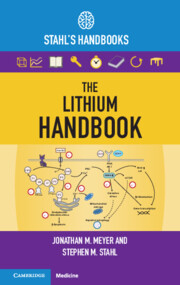Book contents
- The Lithium Handbook
- Reviews
- The Lithium Handbook
- Copyright page
- Contents
- Foreword
- Preface: How to Use This Handbook
- Introduction
- 1 The Efficacy Story
- 2 Renal Handling of Lithium
- 3 Clinical Pharmacokinetics
- 4 Lithium Initiation and Monitoring
- 5 Management of Routine Lithium Related Adverse Effects
- 6 Lithium Toxicity
- 7 Special Populations and Circumstances
- 8 Lithium Discontinuation
- Index
- References
8 - Lithium Discontinuation
Advantages of Gradual Tapering; Suicide Risk Following Discontinuation; Efficacy Upon Resumption
Published online by Cambridge University Press: 09 February 2024
- The Lithium Handbook
- Reviews
- The Lithium Handbook
- Copyright page
- Contents
- Foreword
- Preface: How to Use This Handbook
- Introduction
- 1 The Efficacy Story
- 2 Renal Handling of Lithium
- 3 Clinical Pharmacokinetics
- 4 Lithium Initiation and Monitoring
- 5 Management of Routine Lithium Related Adverse Effects
- 6 Lithium Toxicity
- 7 Special Populations and Circumstances
- 8 Lithium Discontinuation
- Index
- References
Summary
There are numerous reasons for lithium discontinuation, some patient driven and others motivated by clinician concerns [1]. Focused and early attention to common adverse effects may forestall a certain proportion of somatic complaints leading to lithium refusal, but patients may also stop lithium due to the inconvenience of daily medication; diminished perceived need for lithium during periods of euthymia; a desire to remain in a hypomanic or even manic state (e.g. because they feel more creative or productive, or miss the elevated mood); comparative lack of efficacy for depressive episodes compared with the significant impact on mania; a wish not to be reminded of the illness itself; and not wanting their mood to be regulated by medication [2–4].
- Type
- Chapter
- Information
- The Lithium HandbookStahl's Handbooks, pp. 428 - 441Publisher: Cambridge University PressPrint publication year: 2023

